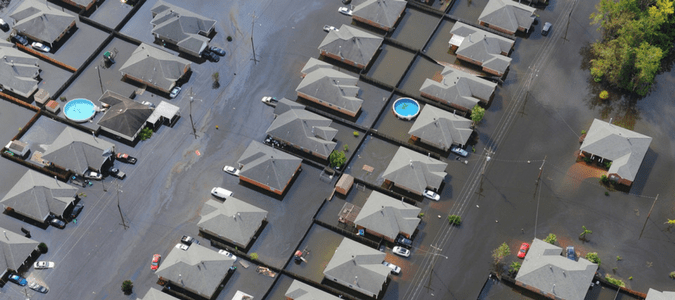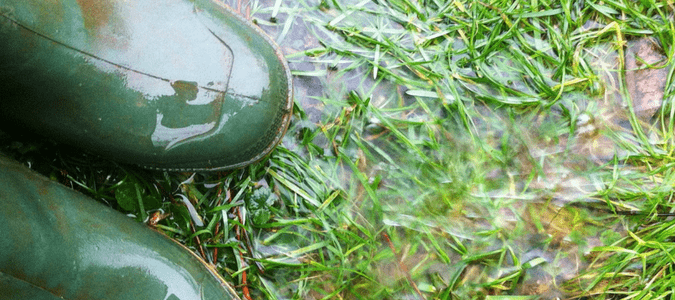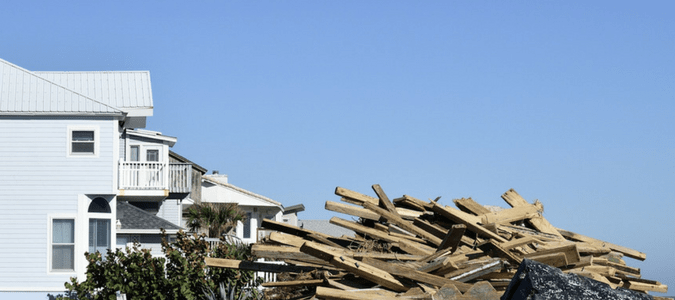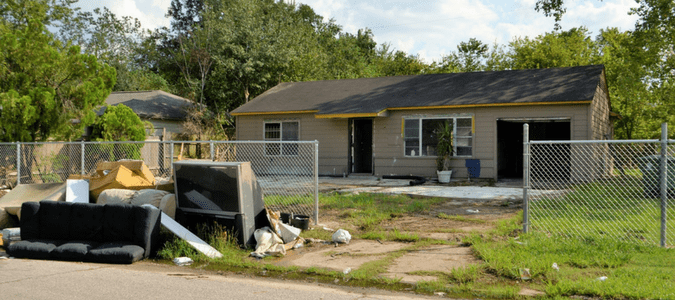
Around the world, the most prevalent kind of natural disaster is flooding. In the United States, floods are the leading cause of weather-related deaths, taking the lives of around 200 Americans each year. During 2016, 19 floods occurred across the United States—the most since record-taking began in 1980. Over the past 36 years, Texas has been the state which has seen the most fatalities from flooding and flash floods.
The adverse effects of floods are numerous, and it can take years to rebuild. So this begs the question: can you do anything to help protect your home from floods? What should you do if your house floods? What can you do after a flood to help your home withstand potential damage from a future flood?
A flooded home isn’t necessarily a total loss. In a Washington Post article, Claudette Hanks Reichel of Louisiana State University’s Agricultural Center, who has written disaster recovery material for the U.S. Department of Housing and Urban Development, stated, “A high water depth doesn’t mean the home is destroyed. But if a house was already structurally compromised by decay, termites or very poor construction, then the flood could be the last straw.”
However, a flood can damage the foundation of your home, which causes other problems, including the risk that windows or doors will break. A flood can damage drywall and cause mold on walls and framing. Framing can also swell from the flood water and needs to be dried and cleaned after the waters have receded. Insulation has to be checked to see if it’s wet. A home’s plywood needs to be dried out. Electrical outlets and switches are typically damaged, and your home’s wiring may be affected. Appliances are also impacted. Most of your furniture and flooring will likely be damaged beyond repair.
Homeowners who understand the adverse effects of floods will be better equipped to manage flooded house repair, clean up after a flood, and prevent mold that homes are vulnerable to after periods of excessive moisture. After we cover those topics, we will provide you with some flood-proof house ideas to protect your property from future flooding events.

Flooded House Repair
The chaos that comes after your home is flooded can be paralyzing. Flood victims can experience symptoms of post-traumatic stress disorder, anxiety, and depression.
When a sudden, excessive or prolonged period of rain causes flooding on your property, you’ll need to take steps to assess the damage and prioritize fixes quickly.
The Federal Emergency Management Agency (FEMA) and the American Red Cross guide homeowners faced with the prospect of making repairs to their homes, yard, and belongings after a flood.
The first risk you may encounter after floodwater recedes is from damaged electrical components. For this reason, turn off your electricity at the main breaker before you begin any cleanup or repairs. Don’t touch electrical equipment if standing in water, and shut off all utilities in a flooded home.
Depending on the extent of your water damage, you may need to remove any items from your home to begin repairs. Clean and disinfect everything that got wet. Floodwater mud can contain sewage, bacteria, and other chemicals that harm your health.
Discard any food that came into contact with water or wasn’t kept at an appropriate temperature.
Once you have cleared your home of your possessions that came into contact with flood water and have determined what can be salvaged, you’ll need to remove any drywall or paneling that got wet. This may be the point at which you hire a contractor so that you can focus on the restoration, cleaning, or disposal of the other contents of your home.
If you decide to take on this project independently, remember the water is soaked into the drywall. So even if your home only received a few inches of water, there is probably a few feet of damage to the drywall. Popular Mechanics has a step-by-step to remove the damaged drywall.
Before you install new drywall, you’ll need to use a moisture meter to ensure studs and other wood framing is dry. Since mold can grow in hidden places, studs should be cleaned and treated during this process.
About 20 percent of homeowners living in coastal areas have flood insurance, which covers the cost of some of these repairs. Standard homeowners insurance doesn’t cover damage to your home from flooding. In some cases, homeowners may qualify for federal disaster relief assistance.
Cleaning Up After a Flood: Tips and Guidance
After you’ve determined that it is safe to enter your home and you’ve turned off the power, you’ll want to document the extent of the damage to your property by taking photos that you can submit to your insurance company.
Before you get started on your cleanup, keep the following tips in mind:
- Your first step should be to notify your insurance agent or company that your home has been flooded.
- Keep you and your children safe and healthy. Wear protective boots, masks, gloves, and other clothing you can discard after cleanup. Check for gas and water leaks and exposed wires. Set a manageable repair schedule and watch for signs of stress in your family.
- Remove any mud left by the floodwater. It can contain chemicals, bacteria, and other dangerous materials you don’t want in your home.
- Open your windows and doors to bring in fresh air if it has stopped raining to reduce indoor humidity and speed up drying. Run all of your fans, including ceiling fans and box fans. The more air can circulate inside your home, the better. Have your air conditioner checked by an HVAC professional before you run it to ensure that you aren’t circulating contaminants and that your ducts are clear of mold.
- Call a contractor to handle more complex repairs. Keep in mind that these companies will be inundated with requests. The earlier you can get on the list of a reputable company, the better. Watch out for scams.
- As mentioned above, your most significant step is removing everything from your wet home. Divide your belongings into piles: what can be cleaned and what needs to be thrown away. Your carpet, furniture, and mattresses will most likely have to be thrown out. Carpets and the pads underneath them can barely ever be saved after flooding events. FEMA’s mantra is that you should discard it if you can’t clean or dry it.
- Your pipes may have been damaged, so have a plumber check for leaks as you begin repairs.
- Drain any standing water from your property, which could be the ideal breeding ground for mosquitoes.
- Contact a lawn care company to assess damage to your trees and lawn and enlist their help in removing fallen limbs and other yard debris, which can provide shelter for rodents and other wildlife.
Cleaning up after a flood is a huge task. Make sure you manage your stress and health during the rebuilding process so that you don’t work too much or wear yourself down.

Preventing Mold After a Flood
Mold can become a severe health risk after flooding and can spread quickly. According to FEMA, mold can grow in your home within 24 hours after a flood. Damage can be extensive if you have to evacuate your home after a flood. Drying out your home is critical in stopping and controlling mold growth.
Carpet, upholstered furniture, drapes, wood, and other porous objects can breed mold.
FEMA recommends homeowners take the following steps to avoid mold growth after a flooding event:
- Open windows for ventilation.
- Wear rubber gloves, eye protection, and a mask when cleaning.
- Mix 1 ½ cups of household bleach in one gallon of water and thoroughly rinse and disinfect impacted areas. Avoid mixing bleach with ammonia, as the fumes are toxic.
- Use a non-ammonia soap or detergent to clean all areas and washable items that came into contact with floodwaters.
- Allow several days for cleaned areas to dry thoroughly. The use of heat, fans, and dehumidifiers can speed up the drying process.
- Find all mold sources and clean them thoroughly. Pay attention to strange odors, which might indicate mold is somewhere you can’t see.
- Remove and discard all materials that can’t be cleaned, like drywall and porous objects. Clean the wall studs where the wallboard has been removed and allow it to dry thoroughly before rebuilding.
- Contact a pest professional to apply treatments to exposed wood, which will protect against mold growth and prevent termite damage in the future.

Flood-Proof House Ideas
Whether you are rebuilding your home after a flood or trying to prep your home when you know flood waters are rising, there are things you can do to minimize damage to your home and property.
If you are rebuilding and live in a flood-prone area, consider the following ideas to make your home less vulnerable to future flooding events:
- Consider elevating your home to prevent significant water damage.
- Consider elevating the heating and cooling systems, your water heater, and your electrical panel, if possible.
- Consider installing water-resistant building materials for floors and waterproof wallboards, such as tile or sealed concrete.
- Consider metal or glass furniture where appropriate.
- Check the slope of the landscape near your home. Does it slope away from your house? Consider enhancing drainage so that water is diverted from your home’s foundation.
To protect your home against damage if your forecast calls for heavy rain, wind, and flooding:
- Clean your gutters and downspouts. Under normal conditions, gutters and downspouts are vital, diverting rainwater away from your home’s exterior and foundation. Make sure these areas are clear of leaves and other debris so that they can serve their purpose in the event of sudden or significant rainfall.
- Move furniture, valuables, and important documents to higher ground. Upholstered furniture, rugs, electronics (including TVs), mattresses, and other treasured belonging should be moved to a second story if you have one or another safe place if not.
- Turn off gas, water, and electricity, provided you can do so safely.
- Place sandbags around your property where water has accumulated in the past so that floodwaters flow away from your living structure.
- Seal windows and doors to prevent water from entering your home’s exterior.
ABC Can Assist With Your Flood Recovery
Cleaning up after a flood can be overwhelming. Homeowners who have their hands full can trust ABC Home & Commercial Services to help manage the adverse effects of flooding. From cleaning up your yard to addressing rodent and mosquito control to getting your air conditioner up and running again, ABC is here to help. Our technicians can also apply Bora-Care, a treatment for exposed wood to prevent mold and termites, on exposed wood that may have sustained water damage. Avoid the risk of having an unknown company handle these post-flood repairs and cleanup tasks, and let ABC handle these tasks so that you can focus on rebuilding.
